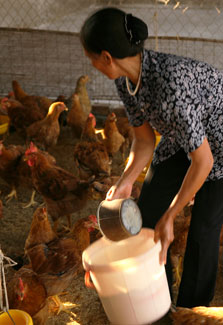NIH encourages veterinarians to consider research careers
May / June 2015 | Volume 14, Issue 3

Photo by Simone D. McCourtie/
World Bank
NIH offers a number of training
opportunities for veterinarian-
scientists, who have useful insights
for studies of diseases that infect both
animals and humans.
From Ebola to bird flu to MERS, diseases that travel between animals and humans are some of the most deadly. They hold tremendous potential to cause pandemics, with constant mutations jeopardizing existing vaccines or treatments. The One Health movement aims to integrate the efforts of multiple disciplines to improve health for people, animals and the environment. It has become a global effort, including annual conferences that bring scientists and policymakers together to consider how to control existing and emerging infectious diseases.
At NIH, a stakeholder meeting -
One Health: Integrating the Veterinarian Scientist into the Biomedical Research Enterprise - was convened recently to consider how the agency might incorporate the One Health concept into its activities and how veterinarian-scientists can be better integrated into biomedical research. The conference was sponsored by the
Office of Research Infrastructure Programs (ORIP), which funds animal-based resources and research projects and plays a central role at NIH for training veterinarian-scientists.
Despite the importance of zoonoses - diseases that are transmitted from animals to humans - and the great potential animal models hold for advancing science, the NIH funds few veterinarian-scientists. Only about 250 received grants from 2008-2012, according to a recent workforce study commissioned by NIH.
"Our overall goal is to find ways to improve the training of veterinarian-scientists in flat budgetary times," said Dr. Franziska Grieder, ORIP director. "By building bridges between scientists with different areas of expertise, we can strengthen multidisciplinary research and more quickly make advances that improve the health of both animals and humans."
Since the majority of diseases that occur in humans also affect animals, it's important that the biomedical research workforce includes practitioners with broad understanding of animal anatomy, physiology, pharmacology and diseases, according to the NIH report. "Recognition of this is evident in the worldwide One Health initiative that is dedicated to improving the health of all species - human and animal - through the integration of human health care and veterinary medicine," the report continued.
Recruitment of potential veterinarian-scientists should begin early, suggested Dr. Peter Ernst of the University of California, San Diego. "We need more outreach so students in middle and high schools understand better what veterinarians can do in terms of research and the overall role of vets in society."
Cancer is one of the many diseases that causes suffering in both animals and humans. The NIH's National Cancer Institute (NCI) manages a combined residency/Ph.D. program to encourage veterinary graduates to do research in core diagnostics, pathology and other topics, with a view to completing their dissertation and receiving a degree from their home institution. NCI also coordinates one-year and summer pre-doctoral programs geared toward veterinary students.
"The challenge is getting them to apply," observed Dr. Mark Simpson, of NCI, who oversees the programs. Although the NIH is training about 3,000 research fellows at any one time, veterinarian-scientists are not well-represented. "By engaging veterinarians, it would expose other investigators in training to the benefits of incorporating animals into research and educate them on what D.V.M.s have to offer." For the veterinarians, it exposes them to potential career opportunities in research. So far, 10 D.V.M.-Ph.D. graduates have completed the combined residency/Ph.D. program, with six currently in tenure-track positions.
The main avenue at NIH for potential veterinarian-scientists to receive training is through programs supported by ORIP, which include pre-doctoral, postdoctoral and summer programs. In addition, veterinary students interested in research are eligible to apply to the Medical Scientist Training Program, offered by the National Institute for General Medical Sciences (NIGMS). For those interested in exploring research in low-resource settings, Fogarty offers a yearlong, mentored research experience through its
Global Health Program for Scholars and Fellows.
Just as with Ebola, the next pandemic may also be traced to animals that infect humans. Incorporating more veterinarian-scientists into NIH research could be vital to controlling the next outbreak. As Dr. Peter Preusch of NIGMS observed, "Anything that broadens the base of science is to the good and could be helpful to research careers down the line."
More Information
Fogarty-supported veterinary research:
Fogarty-supported zoonotic research:
NIH Resources:
One Health resources:
Reviewed January 15, 20201
To view Adobe PDF files,
download current, free accessible plug-ins from Adobe's website.